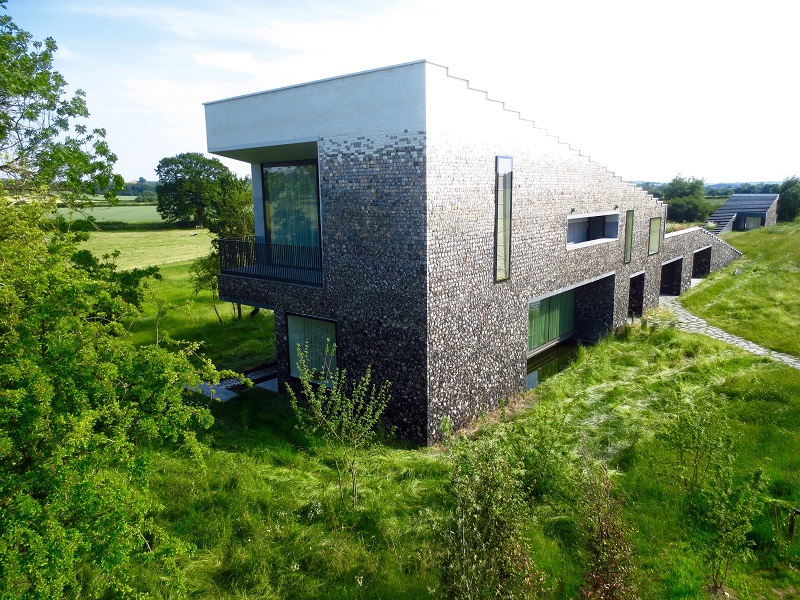Natural stone
Contents |
[edit] Introduction
In the world of architecture, in a sector where aesthetics lead the way and individuality is a unique selling point, natural stone can be the ideal material.
Quarried and mined from the earth, bearing a unique characteristic that is the result of complex geological processes, natural stone offers the specifier more than just a material, it offers a story. No two pieces of natural stone will be exactly the same, and when embraced, this unique material can provide a wealth of options in both texture and colour.
[edit] Stone selection
Choosing the right material for a project is crucial, and there are three key steps to follow to ensure the correct selection:
- The first step is to ensure that samples give a true representation of what the final product will look like. One key factor in this is looking at range/control samples. These will show you the range of geological characteristics typically found within the bed of stone as opposed to the small snapshot you would find in a single indicative sample piece. This helps avoid any confusion as to what the finished floor, wall or countertop will look like. However, it is worth bearing in mind that this is a natural product, and so each stone will have its own unique features.
- The second step is the quarry or mine visit. It is strongly advised that a visit is made so that the stone proposed for the project can be carefully inspected. This is also the ideal stage at which to involve an independent stone consultant to provide an expert opinion.
- The last of these three steps is the technical assessment of the stone. Various tests can help build a picture of a stone’s potential suitability for a particular application, and whilst past projects are a good indicator, recent test data on the CE certificate and Declaration of Performance should be examined. Natural stone is the ideal material for a wide range of applications, but choosing the right materials for the desired application is important, and this is where testing can really help.
[edit] What does natural stone offer the architect?
[edit] Texture
From the fossils found in limestone to the natural, subtle layers of slate, texture is a strong selling point for natural stone. The three-dimensional dynamic that a feature wall of unpolished, naturally-textured stone can provide can be stunning and is a trend that is on the increase.
Unlike many other materials the same piece of stone can be finished in a number of ways to provide the texture best suited to the application. Flamed, honed, blasted, sanded, polished and line textured are all finishes that can give the same piece of stone a very different appearance.
[edit] Impact
The geological striations and natural colour streaks found in marble creates a striking aesthetic suitable for a wide range of applications, from hotel lobbies and city cladding projects through to floors and church steeples. In a market where individuality is key, the unique visuals that natural stone can create are striking, bringing a strong identity to interior spaces of all description.
[edit] Durability
As a result of the geological processes, the thousands of years of compression, natural stone can be an incredibly hard wearing material. You need only look at the centuries old, limestone clad streets of London, the granite paved streets of Aberdeen or the Clipsham rich buildings of Oxford to see evidence of the longevity of this natural material.
[edit] How to find the right natural stone firm?
Stone Federation are the official trade association for the natural stone industry, with more than 100 years’ experience in connecting architects with the best materials and professionals. It has a membership of more than 240 natural stone firms, covering everything from international stone suppliers and British quarry operators through to design consultants and sealant manufacturers. Each member is vetted and approved and have access to a vast resource of technical backup, training, and guidance documents on all the latest Government legislation and guides to best practice.
The Natural Stone Source Book is the Stone Federation flagship publication and acts as a source of information and inspiration, containing a full directory of members alongside project profiles. There is also a ‘Search for a Member’ tool on the Stone Federation website, and a free technical helpline offering advice on everything from stone selection and tolerances to British Standards and slip resistance.
--Stone Federation Great Britain
[edit] Related articles on Designing Buildings Wiki
- 2016 Natural Stone Awards.
- Building with structural stone.
- Chert.
- Choosing stone.
- Defects in stonework.
- Finding stone to conserve historic buildings.
- Gravel.
- Gravel v hardcore v aggregates.
- Inspecting stone sample panels.
- Kentish ragstone.
- Limestone for building.
- Natural stone cladding.
- Natural stone flooring.
- Natural Stone for Interiors.
- Natural stone tiles.
- Patio stone.
- Penarth Alabaster.
- Stone consolidants.
- Sourcing stone to repair Exeter Cathedral.
- Surface Design Show 2017.
- Sustainable stone.
- Types of stone.
Featured articles and news
RTPI leader to become new CIOB Chief Executive Officer
Dr Victoria Hills MRTPI, FICE to take over after Caroline Gumble’s departure.
Social and affordable housing, a long term plan for delivery
The “Delivering a Decade of Renewal for Social and Affordable Housing” strategy sets out future path.
A change to adoptive architecture
Effects of global weather warming on architectural detailing, material choice and human interaction.
The proposed publicly owned and backed subsidiary of Homes England, to facilitate new homes.
How big is the problem and what can we do to mitigate the effects?
Overheating guidance and tools for building designers
A number of cool guides to help with the heat.
The UK's Modern Industrial Strategy: A 10 year plan
Previous consultation criticism, current key elements and general support with some persisting reservations.
Building Safety Regulator reforms
New roles, new staff and a new fast track service pave the way for a single construction regulator.
Architectural Technologist CPDs and Communications
CIAT CPD… and how you can do it!
Cooling centres and cool spaces
Managing extreme heat in cities by directing the public to places for heat stress relief and water sources.
Winter gardens: A brief history and warm variations
Extending the season with glass in different forms and terms.
Restoring Great Yarmouth's Winter Gardens
Transforming one of the least sustainable constructions imaginable.
Construction Skills Mission Board launch sector drive
Newly formed government and industry collaboration set strategy for recruiting an additional 100,000 construction workers a year.
New Architects Code comes into effect in September 2025
ARB Architects Code of Conduct and Practice available with ongoing consultation regarding guidance.
Welsh Skills Body (Medr) launches ambitious plan
The new skills body brings together funding and regulation of tertiary education and research for the devolved nation.
Paul Gandy FCIOB announced as next CIOB President
Former Tilbury Douglas CEO takes helm.
UK Infrastructure: A 10 Year Strategy. In brief with reactions
With the National Infrastructure and Service Transformation Authority (NISTA).
























